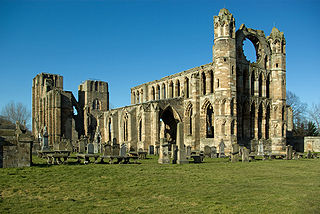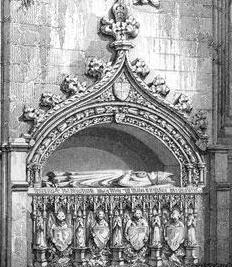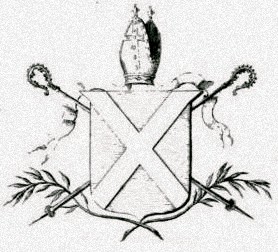Related Research Articles
William de Sancto Claro, or simply William Sinclair, was a 14th-century bishop of Dunkeld. He was the son of Amicia de Roskelyn and Sir William Sinclair, Baron of Roslin. He was the brother of Sir Henry Sinclair, baron of Roslin. After the death of Bishop Matthew de Crambeth in 1309, William was elected to the bishopric. The following year, on 24 February 1310, William was one of twelve Scottish bishops to swear fealty to King Robert the Brus. However, king Edward II of England had his own candidate in mind, John de Leck. William went to the Holy See, where his election was contested by the said John. The diocese of Dunkeld lay vacant for three years. Pope Clement V appointed Cardinal James, cardinal deacon of St George in Velabro, to judge the issue. However, the issue was more or less resolved when, on 22 May 1311, John de Leck was promoted to the Archbishopric of Dublin. When John de Leck took over the see of Dublin on 20 July, he retired from the dispute. The pope then declared William's election canonical, and sent him to Cardinal Berengar Fredol, bishop of Tusculum, in order to be consecrated. On 3 February 1313 king Edward II issued a safe-conduct to William, clearly indicating that the bishop was planning to arrive in England on his way back to Scotland, however Edward demanded cooperation in political matters as a condition. William became a frequent witness to King Robert's charters, but that did not prevent Bishop William, on 24 September 1332, being present at the coronation of Edward Balliol. Bishop William attended the latter's parliaments. William died on 27 June 1337, and was buried in the choir of Dunkeld Cathedral.

Dunkeld Cathedral is a Church of Scotland place of worship which stands on the north bank of the River Tay in Dunkeld, Perth and Kinross, Scotland. Built in square-stone style of predominantly grey sandstone, the cathedral proper was begun in 1260 and completed in 1501. It stands on the site of the former Culdee Monastery of Dunkeld, stones from which can be seen as an irregular reddish streak in the eastern gable.

Elgin Cathedral is a historic ruin in Elgin, Moray, north-east Scotland. The cathedral—dedicated to the Holy Trinity—was established in 1224 on land granted by King Alexander II outside the burgh of Elgin and close to the River Lossie. It replaced the cathedral at Spynie, 3 kilometres (1.9 mi) to the north, that was served by a small chapter of eight clerics. The new and bigger cathedral was staffed with 18 canons in 1226 and then increased to 23 by 1242. After a damaging fire in 1270, a rebuilding programme greatly enlarged the building. It was unaffected by the Wars of Scottish Independence but again suffered extensive fire damage in 1390 following an attack by Robert III's brother Alexander Stewart, Earl of Buchan, also known as the Wolf of Badenoch. In 1402 the cathedral precinct again suffered an incendiary attack by the followers of the Lord of the Isles. The number of clerics required to staff the cathedral continued to grow, as did the number of craftsmen needed to maintain the buildings and surroundings.
John Scotus was a 12th-century Bishop of St. Andrews and Dunkeld.
Robert de Stuteville was Bishop-elect of St Andrews and Bishop of Dunkeld. Robert was dean of Dunkeld as early as 1253, when he was elected to the bishopric of St Andrews on 28 June that year. His election was opposed by the king, Alexander III, and by the bishopric's Céli Dé chapter. The prior and the canons sent Robert to Rome, but a delegation of the king, including Abel de Golynn, was also sent, and the result was that Robert's election was quashed.
Andreas de Moravia was a 13th-century Scottish bishop. He was a younger son of Hugh de Moravia, from the family of Flemish origin who were lords of Duffus and other areas in the Greater Moray region in this period. In the time of Bishop Bricius' episcopate (1203–1222), there was a man called "Andreas" who was rector of the church of St. Peter at Duffus, and this may well have been this Andreas. He may also have been a native Scot.
Richard was a 12th-century bishop of Dunkeld. He got the bishopric of Dunkeld, the second most prestigious bishopric in Scotland-north-of-the-Forth, after serving the King of Scots. He was capellanus Regis Willelmi, that is, chaplain of King William I of Scotland, and had probably been the chaplain to William during the reign of King Malcolm IV. He was consecrated at St Andrews on 10 August 1170, by Richard, former chaplain of King Malcolm IV but now the bishop of St Andrews. Richard continued to have a close relationship with King William I, and was in Normandy with the king in December 1174 when the Treaty of Falaise was signed.
Richard de Prebenda was an early 13th-century bishop of Dunkeld. He had previously been a clerk of King William of Scotland and was appointed to the bishopric in 1203. Records indicate a commission of Pope Innocent III attempting to resolve a dispute between Richard and the prior of St Andrews regarding control of the church of Meigle. He died in May 1210, at Cramond in Midlothian, and was buried on the island of Inchcolm.
John de Leicester was an early 13th-century bishop of Dunkeld. Before becoming bishop, he had been archdeacon of Lothian. He was elected to the bishopric on 22 July 1211. As bishop-elect, he is present when King William of Scotland paid homage to King John of England in 1212. He had been consecrated by June 1212, when a letter from Pope Innocent III to Walter, bishop of Glasgow, and Radulphus, bishop of Brechin, writes of the election and consecration of John, archdeacon of Lothian. John's episcopate would only last a few years; he died on 7 October 1214. His death occurred at Cramond, Midlothian, and was buried on Inchcolm.
Gilbert of Dunkeld was a 13th-century bishop of Dunkeld. He began his career in the diocese as a chaplain to Bishop Hugh de Sigillo. When Hugh's successor as bishop, Matthew the Scot, died unexpectedly in 1229, it was Gilbert whom the chapter chose to elect as Matthew's successor. The details of Gilbert's consecration are unknown. It was during Gilbert's episcopate that Inchcolm Priory was elevated to the status of an abbey. The latter monastic establishment was in the diocese of Dunkeld because it had been an earlier Dunkeld foundation, dedicated, like Dunkeld Cathedral was, to Saint Columba, hence the name Insula Columbae, or in the vernacular, Innse Choluim, "island of Columba". On 22 May 1235 Pope Gregory IX wrote to Gilbert authorizing the elevation, and, moreover, instructing Gilbert to donate to the monastery a portion of the see's revenues. Gilbert died sometime in the year 1236, and was buried in Inchcolm Abbey. There survives one charter of bishop Gilbert.
Clement was a 13th-century Dominican friar who was the first member of the Dominican Order in Britain and Ireland to become a bishop. In 1233, he was selected to lead the ailing diocese of Dunblane in Scotland, and faced a struggle to bring the bishopric of Dunblane to financial viability. This involved many negotiations with the powerful religious institutions and secular authorities which had acquired control of the revenue that would normally have been the entitlement of Clement's bishopric. The negotiations proved difficult, forcing Clement to visit the papal court in Rome. While not achieving all of his aims, Clement succeeded in saving the bishopric from relocation to Inchaffray Abbey. He also regained enough revenue to begin work on the new Dunblane Cathedral.

Auchtertool is a small village in Fife, Scotland. It is 4 miles west of Kirkcaldy. The name is from the Gaelic uachdar, meaning upland or heights above the Tiel burn. The Tiel Burn flows a few hundred yards south of the kirk and village, which was formerly known as Milton of Auchtertool. The parish belonged to the diocese of Dunkeld, having been given to Bishop Gregory by King David I in the twelfth century. Soon after, the church was given to the priory of Inchcolm.

Robert de Cardeny was a late 14th and early 15th century Scottish cleric. He was the son of one John Cardeny, and brother of the royal mistress Mariota de Cardeny. His early career is obscure. In 1378–80, King Robert II of Scotland petitioned the Pope for a canonry in the diocese of Moray for one Robert de Cardun, despite the fact that the latter already held canonries and prebends in the diocese of Dunblane and Dunkeld. This Robert de Cardun was both a member of King Robert's household and a student at the University of Paris. Robert had graduated from Paris in 1381 as Licentiate. In 1392 he was a receiver of the "English Nation" at Paris and custodian of the Nation's seal. In 1394 Robert was still in Paris, now as Master Robert de Cardeny
James Livingston was a 15th-century cleric from East Lothian in south-eastern Scotland. Born at an unknown date in the 15th century, he was a son of the Laird of Saltcoats. He chose a career in the church, and became rector of the churches of Forteviot and Weme, and vicar of Innerleithen. By 1474, if not earlier, he had become dean for the whole diocese of Dunkeld. After the death of Thomas Lauder, Livingston was chosen as his successor as Bishop of Dunkeld. Although Livingston's appointment was contested at Rome by Thomas Spens, Bishop of Aberdeen, who wanted to be translated to Dunkeld, Livingston was consecrated on 30 June 1476. Livingston's episcopate is relatively obscure; he spent a good deal of time in Edinburgh, where he is witness to several charters. He died at Edinburgh, on 28 August 1483. He was buried in Inchcolm.
George Brown was a late 15th-century and early 16th-century Scottish churchman. He first appears on record in 1478 as the rector of the church of Tyningham, and is called a clerk of the diocese of Brechin. In 1482, he was selected to be Chancellor of the diocese of Aberdeen.

Alexander Rose (1647–1720) was a Scottish scholar, minister and bishop. He was a Church of Scotland minister before becoming Professor of Divinity at the University of Glasgow and Principal of St Mary's College, St Andrews. He rose to become Bishop of Moray and then Bishop of Edinburgh. He was responsible for failing to convince King William III of England that the Scottish bishops could be trusted, leading to the abolition of Episcopacy in Scotland. Rose continued as a nonjuring bishop, eventually becoming leader of the informal and embryonic Scottish Episcopal Church.
Alexander Stewart was a 14th-century Scottish bishop. Probably from Menteith, he appears in the sources from the first half of the 1340s, possessing a university degree and holding the position of Archdeacon of Ross. He was active at the papal curia in the second half of the decade as a papal chaplain and administrator, before being provided as Bishop of Ross in 1350, a position he held until his death in 1371.

Albin was a 13th-century prelate of the Kingdom of Scotland. A university graduate, Albin is known for his ecclesiastical career in the diocese of Brechin, centred on Angus in east-central Scotland.
Walter de Coventre was a 14th-century Scottish ecclesiastic. There is no direct evidence of his birthdate, his family, or his family's origin, although he may have come from the region around Abernethy, where a family with the name de Coventre is known to have lived. Walter appeared in the records for the first time in the 1330s, as a student at the University of Paris. From there he went on to the University of Orléans, initially as a student before becoming a lecturer there. He studied the arts, civil law and canon law, and was awarded many university degrees, including two doctorates. His studies were paid for, at least partially, by his benefices in Scotland. Despite holding perhaps more than five benefices at one stage, he did not return to Scotland until the late 1350s.

The Diocese or Archdiocese of St Andrews was a territorial episcopal jurisdiction in early modern and medieval Scotland. It was the largest, most populous and wealthiest diocese of the medieval Scottish church, with territory in eastern Scotland stretching from Berwickshire and the Anglo-Scottish border to Aberdeenshire.
References
- Dowden, John (1912). Thomson, J. Maitland (ed.). The Bishops of Scotland. Glasgow.